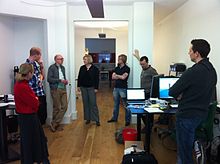In software development, a lead programmer is responsible for providing technical guidance and mentorship to a team of software developers. Alternative titles include development lead, technical lead, lead programmer, or lead application developer. When primarily contributing a low-level enterprise software design with focus on the structure of the app, e.g. design patterns, the role would be a software architect
Agile software development is the mindset for developing software that derives from values agreed upon by The Agile Alliance, a group of 17 software practitioners in 2001. As documented in their Manifesto for Agile Software Development the practitioners value:
In agile principles, timeboxing allocates a maximum unit of time to an activity, called a timebox, within which a planned activity takes place. It is used by agile principles-based project management approaches and for personal time management.
Lean software development is a translation of lean manufacturing principles and practices to the software development domain. Adapted from the Toyota Production System, it is emerging with the support of a pro-lean subculture within the agile community. Lean offers a solid conceptual framework, values and principles, as well as good practices, derived from experience, that support agile organizations.
Agile management is the application of the principles of Agile software development and Lean Management to various management processes, particularly product development. Following the appearance of The Manifesto for Agile Software Development in 2001, Agile techniques started to spread into other areas of activity. The term Agile originates from Agile manufacturing - which in the early 1990s had developed from flexible manufacturing systems and lean manufacturing/production.

Scrum is an agile team collaboration framework commonly used in software development and other industries.

Jeff Sutherland is one of the creators of Scrum, a framework for product management. Together with Ken Schwaber, he presented Scrum at OOPSLA'95. Sutherland contributed to the creation of the Agile Manifesto in 2001. Along with Ken Schwaber, he wrote and maintains The Scrum Guide, which contains the official definition of the framework.

A burndown chart or burn down chart is a graphical representation of work left to do versus time. The outstanding work is often on the vertical axis, with time along the horizontal. A burn down chart is a run chart of remaining work. It is useful for predicting when all of the work will be completed. It is often used in agile software development methodologies such as Scrum. However, burn down charts can be applied to any project containing measurable progress over time.
In software engineering, a software development process or software development life cycle (SDLC) is a process of planning and managing software development. It typically involves dividing software development work into smaller, parallel, or sequential steps or sub-processes to improve design and/or product management. The methodology may include the pre-definition of specific deliverables and artifacts that are created and completed by a project team to develop or maintain an application.
Lean project management is the application of lean concepts such as lean construction, lean manufacturing and lean thinking to project management.

Mike Cohn is one of the contributors to the Scrum software development method. He is one of the founders of the Scrum Alliance.
A programming team is a team of people who develop or maintain computer software. They may be organised in numerous ways, but the egoless programming team and chief programmer team have been common structures.

Kanban is a lean method to manage and improve work across human systems. This approach aims to manage work by balancing demands with available capacity, and by improving the handling of system-level bottlenecks.

A kanban board is one of the tools that can be used to implement kanban to manage work at a personal or organizational level.

A cumulative flow diagram is a tool used in queuing theory. It is an area graph that depicts the quantity of work in a given state, showing arrivals, time in queue, quantity in queue, and departure.
Disciplined agile delivery (DAD) is the software development portion of the Disciplined Agile Toolkit. DAD enables teams to make simplified process decisions around incremental and iterative solution delivery. DAD builds on the many practices espoused by advocates of agile software development, including scrum, agile modeling, lean software development, and others.
eXtreme Manufacturing (XM) is an iterative and incremental framework for manufacturing improvement and new product development that was inspired by the software development methodology Scrum and the systematic waste-elimination (lean) production scheduling system Kanban(かんばん ).
Scrumban is an Agile aligned approach to product delivery which is a hybrid of Scrum and Kanban. Scrumban was originally designed as a way to transition from Scrum to Kanban.
The scaled agile framework (SAFe) is a set of organization and workflow patterns intended to guide enterprises in scaling lean and agile practices. Along with disciplined agile delivery (DAD) and S@S (Scrum@Scale), SAFe is one of a growing number of frameworks that seek to address the problems encountered when scaling beyond a single team.
Agile learning generally refers to the transfer of agile methods of project work, especially Scrum, to learning processes. Likewise, agile learning proceeds in incremental steps and through an Iterative design which alternates between phases of learning and doing. The tutors rather have the role of a learning attendant or supporter. In a narrower sense, it is intended to allow competence-oriented, media-based learning in the work process within companies. In addition, the term can take several other meanings and is also often used within e-learning and online environments.






